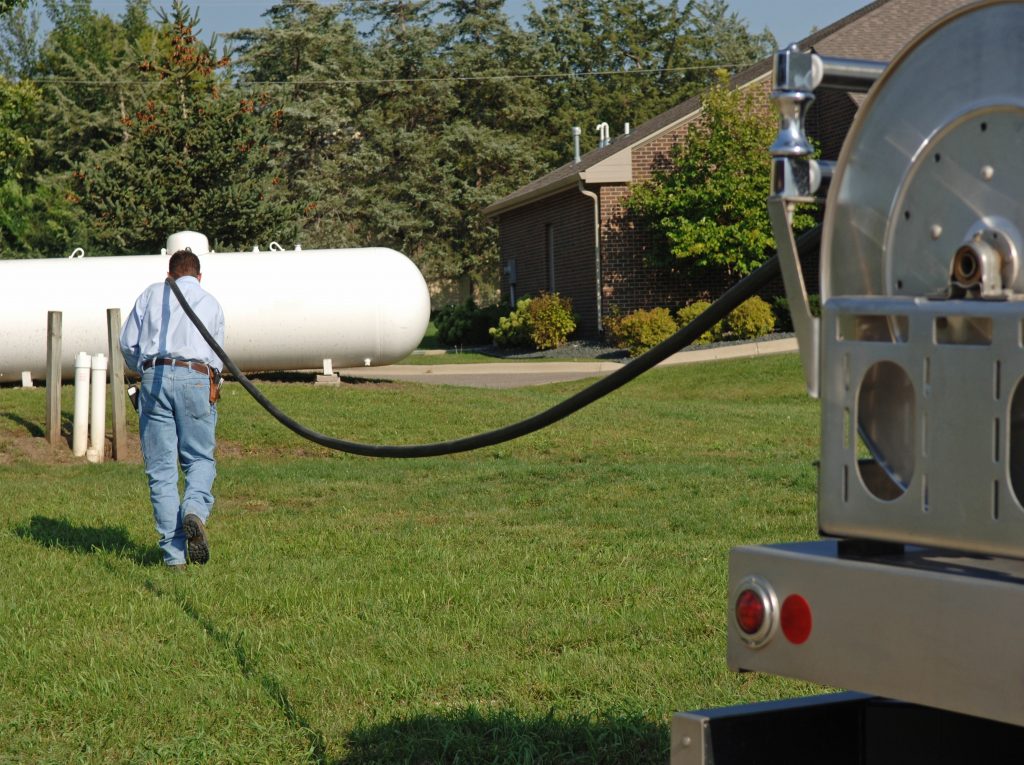New portable devices provide utility and protection for propane workers.

The little black clip-on device is small – the size of a walkie-talkie – but can deliver big troubleshooting and safety benefits for propane workers. Part of a customizable safety system being used by CHS Propane locations around the country, the easy-to-use devices provide essential protection for workers across all aspects of propane operations – including delivery, installation, maintenance and service work.
“Safety is our top priority, and we promote it through programs that enhance safety knowledge and foster safe practices among all CHS employees and customers,” says Kenton Sonnenburg, CHS Energy Equipment manager. “We’re excited to be offering this industry-leading safety technology, and we’ve been getting positive feedback from locations that have been using it this past year.”
He says three key features make these portable safety devices invaluable to propane workers: gas detection sensors, lone worker protection and cellular or satellite access for real-time safety monitoring, even in remote areas.
Pinpointing gas leaks

Outfitted with up to five gas detection sensors, the handheld monitors deliver precise gas level readings, alert users to hazardous conditions and assist in quickly identifying and isolating leaks. For use around propane systems, the devices can be equipped to monitor for carbon monoxide, oxygen levels, hydrogen sulfide, anhydrous ammonia and other combustible gases.
Justin March, field service technician for CHS Northwest, based in Spokane, Wash., can attest to the value of this feature. “I typically set the device to a pre-entry mode when I walk around a storage tank or structure, or enter a house. And recently it helped me identify carbon monoxide being emitted from a customer’s propane heater.”
“I’ve also used it to find pinhole leaks in black pipe in basements, which is normally a challenging job,” he adds. “The detector is extremely accurate.”
Detecting a fall
For employees like Mike Coartney, who are often working by themselves, it’s reassuring to know that help will be there if you need it. The senior terminal operator at CHS Carrollton Propane Terminal in a fairly rural part of northcentral Missouri, says he wouldn’t think of letting his feet leave the ground without clipping on his monitor. “For any task on an elevated surface, even when using a harness, a person can slip. You could fall or be dangling off the ground and need help. The device can detect a fall or if motion stops, and an actual person will come on to ask if you need help. If the worker can’t respond, emergency help is sent.”
The monitors have either cellar or satellite connectivity, which links the worker in real time to a monitoring center, staffed with people trained to respond in emergencies. The system uses GPS tracking to provide exact coordinates to first responders. Additionally, each monitor can have a customized notification list to directly notify the worker’s supervisor or other employees that there is an issue.
Coartney says the Carrollton terminal also uses a larger stationary version of the monitor to provide the same monitoring and gas detection features of the handheld units. “It is located between pumps at the terminal, is charged with a solar panel and can alert me and the authorities if there is a gas leak, which is especially important in the off hours, when no one is there.”
Help in remote areas
Much of the year, driving the wooded and mountainous roads outside Spokane can be a scenic perk for Justin Edmonds, field service technician for CHS Northwest. “During the winter months, though, those roads become treacherous. If I slide off into the snow, in a particularly remote area, I depend on the SOS feature on my safety monitor to bring help,” he says. “That feature is really invaluable, as is having the satellite connectivity option, since there often isn’t reliable cell service in those areas.”
A manual emergency SOS latch on each portable monitor can be flipped when the worker is in need of help, and generates instant visual and audible alarms, as well as alerting the monitoring center and call list.
Edmonds and his colleagues have been using the safety system for over a year now and admit it took a while for everyone to understand and appreciate all the features and utilities it offers. “It’s very easy to use but requires everyone getting in the habit of clipping it on every time you get out of the truck.”
He adds, “All it takes is one accident, or a near accident, for a user to realize its value.”
To learn more about this safety system or how to utilize the CHS safety reimbursement program to invest in your employees’ safety, contact CHS Energy Equipment at 800-852-8186 and select option 1, or email Propane.EquipmentFax2@chsinc.com.
